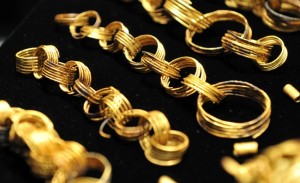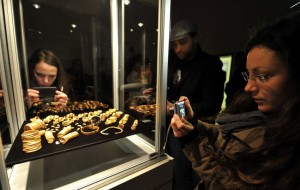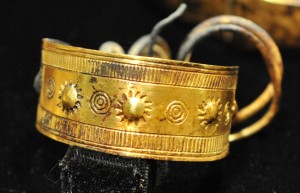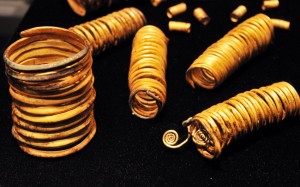 In April of 2011, an archaeological investigation on the future site of the North European Gas Pipeline (NEL) near the Lower Saxony town of Syke unearthed a large hoard of Bronze Age gold jewelry, the regional Ministry of Culture revealed today. An engineer located the cache while exploring an excavation area with a metal detector. They found several corroded bronze pins, a small gold spiral curl and an engraved gold cuff, then decided to cut a solid two-foot square block of the earth around the discovery spot instead of digging any further.
In April of 2011, an archaeological investigation on the future site of the North European Gas Pipeline (NEL) near the Lower Saxony town of Syke unearthed a large hoard of Bronze Age gold jewelry, the regional Ministry of Culture revealed today. An engineer located the cache while exploring an excavation area with a metal detector. They found several corroded bronze pins, a small gold spiral curl and an engraved gold cuff, then decided to cut a solid two-foot square block of the earth around the discovery spot instead of digging any further.
 The block was sent to the State Conservation Office in Hanover where researchers took detailed CT scans so they could know exactly where every artifact was before attempting recovery. They even created a 3D plastic model of the block based on the scans so the conservator could dissect the block and remove each piece with utmost precision.
The block was sent to the State Conservation Office in Hanover where researchers took detailed CT scans so they could know exactly where every artifact was before attempting recovery. They even created a 3D plastic model of the block based on the scans so the conservator could dissect the block and remove each piece with utmost precision.
The final tally was 117 individual items — gold rings, spirals, cloak pins — packed inside a linen bag closed with four bronze needles. The total weight of the artifacts is 1.8 kilos, about four pounds, making it one of the largest prehistoric gold finds in Central Europe.
 The gold cuff turned out upon closer investigation to be a cloak pin, decorated with circles and sun symbols. Those decorations date the piece to 1400 B.C., the Middle Bronze Age. The remains of the linen bag are in the process of being radiocarbon dated, but we don’t have the results on that yet.
The gold cuff turned out upon closer investigation to be a cloak pin, decorated with circles and sun symbols. Those decorations date the piece to 1400 B.C., the Middle Bronze Age. The remains of the linen bag are in the process of being radiocarbon dated, but we don’t have the results on that yet.
 University of Hanover archaeological metallurgists examined the artifacts using X-ray fluorescence (XRF) testing, scanning electron microscopy and Laser Ablation Mass Spectrometry (LAMS). The results were surprising, even revolutionary, providing a whole new insight into the capabilities and range of our Bronze Age ancestors. For one thing, the gold was not hammered but drawn, a more advanced technique that historians didn’t think was used during the Bronze Age. The gold content of each artifact is 90 percent. Such a high percentage indicates that the jewels were not made from natural gold, but rather from recycled gold. They also discovered that the origin of all the metal in the hoard, gold and bronze, is Central Asia, not a local source.
University of Hanover archaeological metallurgists examined the artifacts using X-ray fluorescence (XRF) testing, scanning electron microscopy and Laser Ablation Mass Spectrometry (LAMS). The results were surprising, even revolutionary, providing a whole new insight into the capabilities and range of our Bronze Age ancestors. For one thing, the gold was not hammered but drawn, a more advanced technique that historians didn’t think was used during the Bronze Age. The gold content of each artifact is 90 percent. Such a high percentage indicates that the jewels were not made from natural gold, but rather from recycled gold. They also discovered that the origin of all the metal in the hoard, gold and bronze, is Central Asia, not a local source.
Research on the find is ongoing, as are excavations all along the 275-mile pipeline route through Germany, from the Bay of Greifswald in the northeast on the Baltic Sea through Lower Saxony in the northwest. The pre-pipeline excavations are some of the largest archaeological projects in Europe, employing hundreds and discovering not just pounds of Bronze age gold, but also Stone Age hearths complete with mother figure, hundreds of cemeteries with cremation urns, Roman-era grave goods, Neolithic graves, a gold ring with a blue pearl from 400 A.D., beads and wood remnants from Egyptian trade goods, and much more. Only 10-20% of the sites were known before the pipeline project began.
This is financed by the developers building the pipeline, who must get an all-clear from the archaeologists before they can begin building on any given spot. They started the surveys in 2010 to ensure that they would have a lot of time to excavate and thus help minimize the chances of delays once construction begins.
I am amazed at the craftsmanship of the pieces. It is mindboggling how people over 3000 years ago could craft jewelery like that without modern tools or devices. It is also puzzling how hoards like this get lost in the first place.
I am amazed by the quality of the goldsmithing as well. It’s a testament to the great skill of Bronze Age metal work (and to gold’s obliging malleability, I suspect).
Found a spirial cloak pin a couple of years ago in an old house. Threw it to the side and forgot about it. Husband started cleaning it the other day and now we think it is gold. Not sure what I have here but it is old. Any ideas
Laurie
Newhook
My name is Emerson and I did some research on gold buried in Carpathians Mountains.I need someone who is passionate about finding treasures and a few metal detectors, I know the area where it would be very high chances to find verry old Dacian gold( Since living near).You can make research on google maps Sarmizegetusa, Hunedoara etc etc .
I hope to receive an answer.
It is amazing. But the toolmare the same as today, and the gold is soft and easy to work in. They also had nothing but their time, and fantasy to design artifact’s and the froms was made out of clay and hosr maneur. The brain is the same as people have roday but they just had another time and other believes wich they used to do the artifact’s by. And some of the gold got hidden if they where tresdened by robbers, war or conflict. And the only safe thay had was the ground to hide their valuables in. So if they died by getting killed og ilness, no one would know where the treasure was buried. Or they would offer it to the gods.